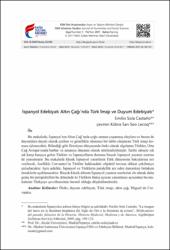| dc.contributor.author | Castaño, Emilio Sola | |
| dc.contributor.other | Lecoq, Kübra Sarı Seo | |
| dc.date.accessioned | 2017-07-04T07:06:51Z | |
| dc.date.available | 2017-07-04T07:06:51Z | |
| dc.date.issued | 2017 | |
| dc.identifier.citation | CASTANO, Emilio Sola, & çeviren Kübra Sarı Seo LECOQ, "İspanyol Edebiyatı Altın Çağı’nda Türk İmajı ve Duyum Edebiyatı", FSM İlmî Araştırmalar İnsan ve Toplum Bilimleri Dergisi, 9 (2017): 395-411. | en_US |
| dc.identifier.uri | http://dergi.fsm.edu.tr/index.php/ia/article/view/805 | |
| dc.identifier.uri | https://hdl.handle.net/11352/2500 | |
| dc.description.abstract | Bu makalede, İspanya’nın Altın Çağ’ında çoğu zaman yaşanmış olaylara ve bazen de
duyumlara dayalı olarak çizilen ve genellikle olumsuz bir tablo oluşturan Türk imajı konusu
işlenecektir. Bilindiği gibi Hristiyan dünyasında öteki olarak algılanan Türkler, Orta
Çağ Avrupa’sında barbar ve amansız düşman olarak nitelendirilmiştir. Tarihi süreçte sık
sık karşı karşıya gelen Türkler ve İspanyolların durumu birçok İspanyol yazarın eserine
de yansımıştır. Bu makalede klasik İspanyol yazarların Türk dünyasına bakışlarına yer
verilecek, özellikle Cervantes’in Türkler hakkındaki objektif tavrına dikkat çekilmeye
çalışılacaktır. Aynı şekilde, İspanyol ve Türklerin paralellik arz eden durumları birtakım
örneklerle açıklanacaktır. Birçok klasik dönem İspanyol yazarın eserlerini ele alarak daha
geniş bir perspektiften bu dönemde ki Türklere bakış açısını yansıtması açısından bu makalenin
Türkçeye çevrilmesinin önemli olduğu düşünülmektedir. | en_US |
| dc.description.abstract | In this article, the issue of Turkish image which was based on sometimes rumours and
mostly the events that happened in the Golden Age of Spain –and also usually appears
as a negative image- will be discussed. As it is known, the Turks, who were perceived
as “the other” in the Christian world, have been described as barbarian and relentless
enemies in Medieval Europe. The situation of the Turks and the Spaniards, who often
confronted with each other throughout history, was reflected in the work of many Spanish
writers. In this article, the classical Spanish writers’ views about the Turkish world will be
discussed and especially objective attitude of Cervantes towards the Turks will be emphasized.
Furthermore, parallel cases of the Spanish and Turks will be explained with some
examples. Furthermore, parallel cases of the Spanish and Turks will be explained with
some examples. It is thought that it is important to translate this article into Turkish as it
reflects the viewpoint about Turks in this (i.e. classical) period from a wider perspective
by referring to the Works of many classical period Spanish writers. | en_US |
| dc.language.iso | tur | en_US |
| dc.publisher | FSM Vakıf Üniversitesi | en_US |
| dc.rights | info:eu-repo/semantics/openAccess | en_US |
| dc.subject | Öteki | en_US |
| dc.subject | Duyum edebiyatı | en_US |
| dc.subject | Türk imajı | en_US |
| dc.subject | Altın çağ | en_US |
| dc.subject | Miguel de Cervantes | en_US |
| dc.subject | The Other | en_US |
| dc.subject | Rumour literature | en_US |
| dc.subject | Turkish image | en_US |
| dc.subject | Golden age | en_US |
| dc.title | İspanyol Edebiyatı Altın Çağı’nda Türk İmajı ve Duyum Edebiyatı | en_US |
| dc.title.alternative | The Turkish Image in Spanish Literature of the Golden Age and The Rumour Literature | en_US |
| dc.type | article | en_US |
| dc.contributor.department | Alcalá Üniversitesi | en_US |
| dc.relation.publicationcategory | Makale - Ulusal - Editör Denetimli Dergi | en_US |



















